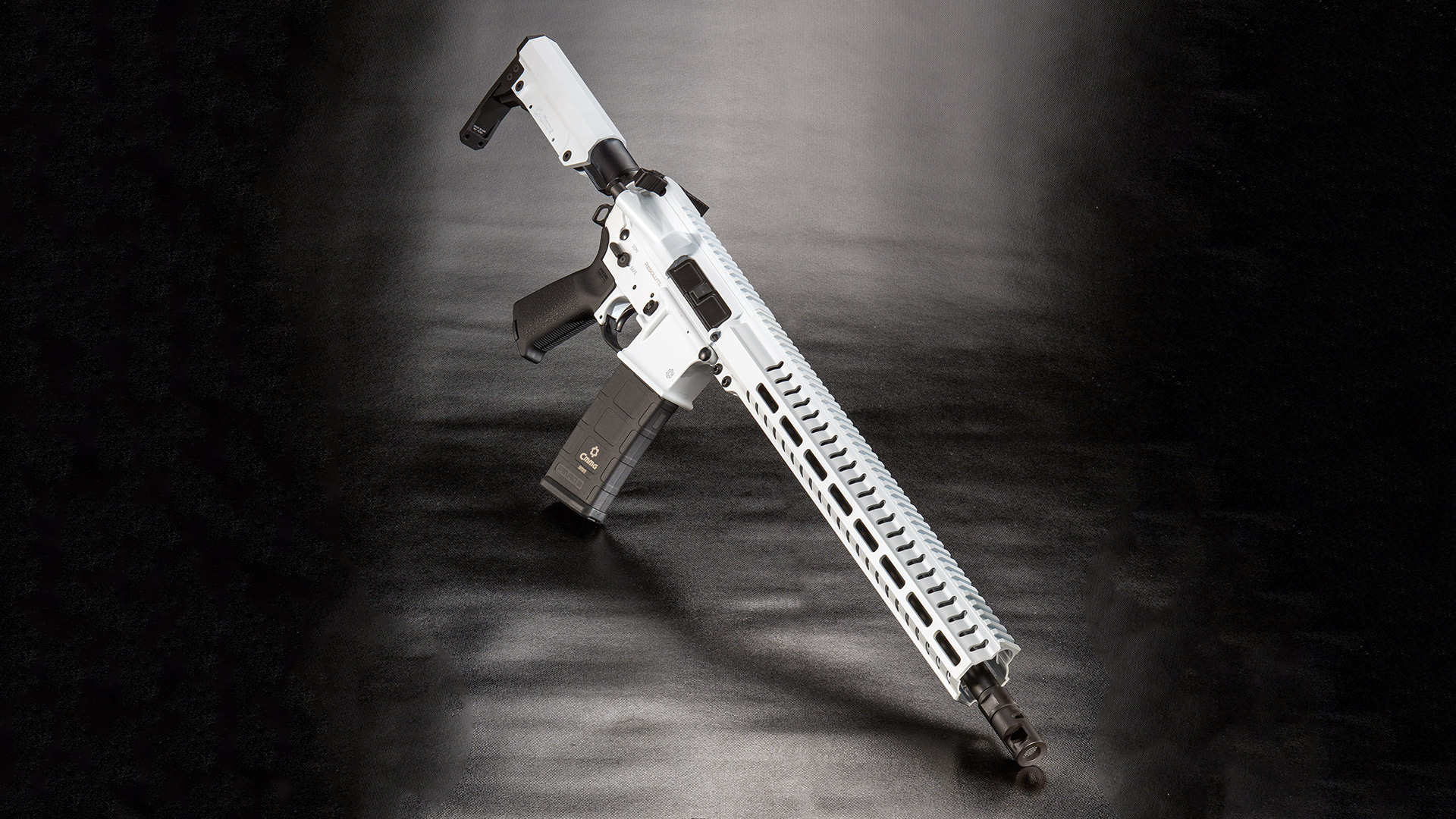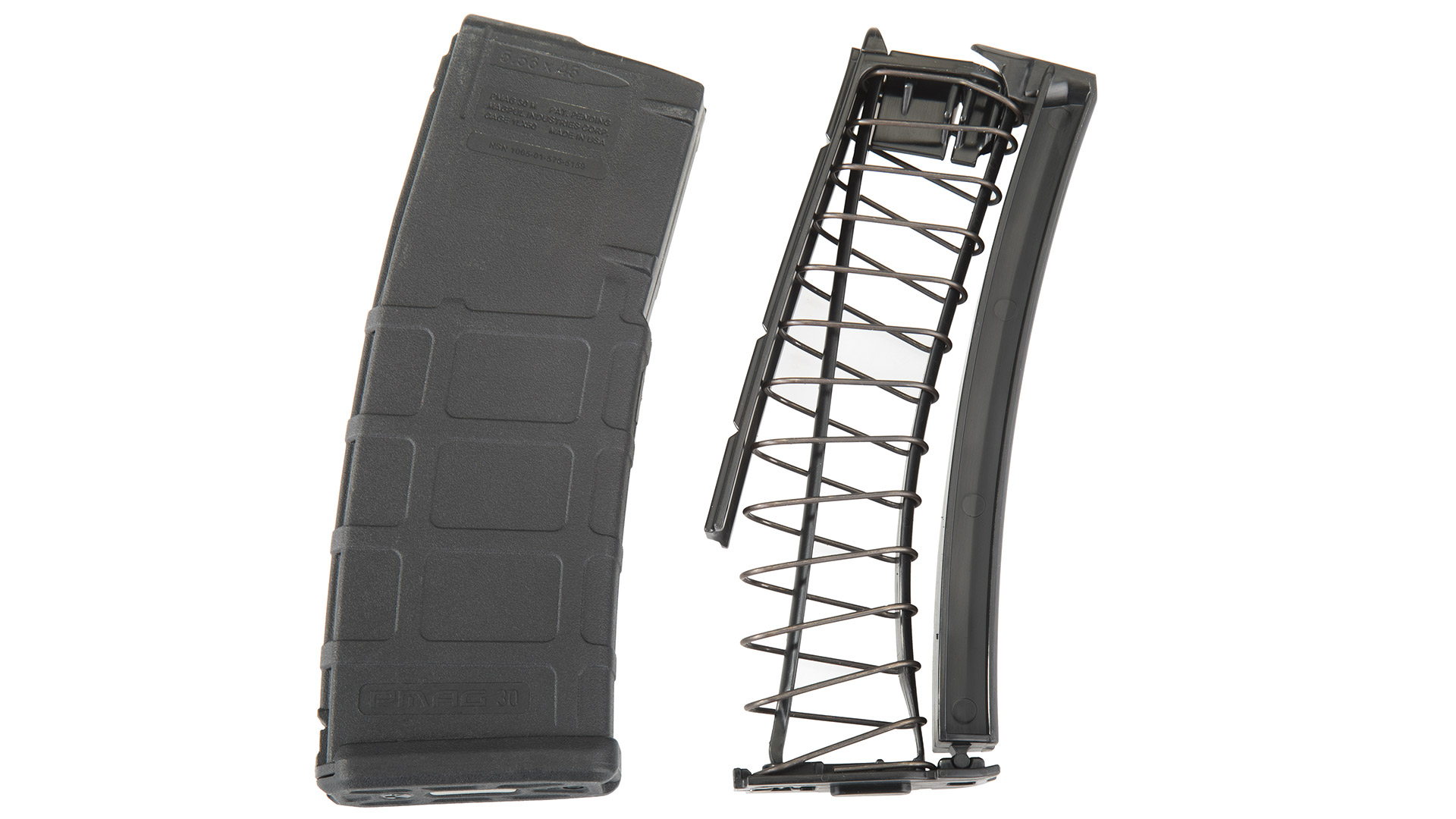
Established in 2002 in Boonville, MO, CMMG has earned an excellent reputation as a manufacturer of high-quality American-made rifles, carbines and .22 LR conversions kits based upon the AR-15 platform. The newest addition to the CMMG 9mm PCC line, the “Stormtrooper” does nothing to detract from that. And it will certainly garner a lot of attention on the range.

The Gun
Although I refer to the gun as the “Stormtrooper,” the official designation is the Resolute 300 Mk4 9mm ($1,624.95, cmmginc.com). But, the cerakote finish in CMMG’s Stormtrooper white color makes the nickname easy to understand.
Like the rest of the Resolute 300 line, the 9mm “Stormtrooper” features a 16.1-inch barrel (1:10-inch twist) that is capped by CMMG’s SV muzzle brake with the standard 1/2-28 threads. The receiver is a forged 7075-T6 AL M4 upper, with an AR-15 lower, and uses the company’s patent-pending Radial Delayed Blowback (RDB) action. The RDB features the same rotating locking lugs as the AR-15, but with a lighter mass in the bolt-carrier group (BCG), and in a direct blowback action.

Furniture consists of the CMMG RML15 M-Lok handguard, Magpul MOE pistol grip, integral Picatinny rail and CMMG’s six-position Ripstock buttstock.
The operating controls are straight AR-15, and done in black to contrast with the white cerakote finish. They’re the standard left-side bolt release and a right-side magazine release. The two-position safety is there as well, but is ambidextrous on the Resolute line. CMMG’s oversize ambidextrous charging handle is included. The trigger assembly is the well-respected Geissle Automatics SSA two-stage.

Empty weight for the “Stormtrooper” is 6 pounds, 3 ounces and the gun ships with one Magpul 30-round 9mm magazine. There’s an additional internal spring and follower assembly that allows any Magpul AR-15 5.56mm magazine to be easily converted to 9mm. As with all CMMG products, the Stormtrooper is covered by its lifetime quality guarantee.
On the Range
Taking the gun out of the box I cracked the rifle, pulled the BCG and lubed it. I had a SIG Romeo3 Max on a Picatinny mount that was currently unemployed and it mounted easily.

Given the multiple games this gun can play I wanted to test a variety of factory loads and bullet weights. The following test rounds were selected: Atlanta Arms Select 100-grain FMJ RN Steel Challenge; Koenig Shooting Sports 110-grain JHP Competition; CCI 115-grain Blazer Brass FMJ-RN; Federal 124-grain American Eagle FMJ RN; Federal Syntech 130-grain PCC and the Federal 147-grain American FMJ-FP. I then headed to my backyard range to zero the gun at 25 yards with the mid-weight 124 Federal load, which I figured would get me close enough with the other loads.
The supplied magazine was quite interesting. It’s a standard Magpul 30-round AR-15 mag, which obviously leaves too much space for the shorter 9mm round. That was solved in the 9mm version by putting a pair of 9mm-sized bumps at the rear of the follower to provide a consistent feed surface, and using the front area of the follower as a feed ramp. It loaded 30 rounds easily.

My experience with AR-15 5.56mm mags has taught me that with the bolt forward, a mag inserted and the charging handle run to chamber the first round—they may not chamber that first round if an odd number of rounds are loaded. That puts the first round on the right side of the follower. They seem to prefer an even number of rounds that puts the first round on the left side of the follower. I checked this with the PMag, and it made no difference—even or odd number, right or left first round, they all fed.
A full 30-round magazine of each of the loads were run through the gun at multiple targets on my range, and then each was accuracy tested from my 25-yard benchrest. The accompanying chart will show the results. I have to note that this is one of the most accurate PCC guns I have tested to date, and it liked all the bullet weights.

With only one magazine a match was out of the question, so I headed over to my club’s weekly Steel Challenge practice day to allow other shooters to run it. The first to grab it was our Match Director, Scott Hartford, (a Grand Master RFRO). I had the 30-round mag full of the 115-grain CCI load, and after emptying that on rapid five-plate runs he loaded 30 rounds of his own 9mm “soft” reload. After 60 rounds, I had to almost resort to physical force to pry the gun from his grasp. He was impressed. Several other M and A Class shooters ran it with their own handloads and were as positive in their opinion as Hartford.

By this point there were well over 450 rounds through the gun, without a single malfunction. And with nothing more than my initial out-of-the box BCG lube. My own tests were with factory loads, but after watching those various handloads run through the gun I got curious.
Like any competitive shooter I want the softest-recoiling load that will meet the required Power Factor and reliably run the gun. The RDB operating action on this gun uses a lighter BCG than other PCC blowback guns, and I wondered if that might allow the use of lighter handloads. So, I dug out my “Mouse Puff” Steel Challenge 9mm load.

This load launches a 120-grain Bayou coated lead bullet at 935 fps (112 PF) from the five-inch barrel on my S&W M&P C.O.R.E. It will run reliably if the gun is clean. It’s perfectly legal in Steel Challenge. It also makes it easy to recover my brass, because it all will be sitting in a neat pile two feet to my right. It won’t run in my PCC or in many of the other 9mm pistols I’ve tried it in. But the Stormtrooper loved it and spit the fired cases out six or seven feet. Recoil wasn’t much, and functioning was perfect. I was surprised by that and decided to include that load in the accuracy tests.
Those who enjoy creatively crafting their reloads to the minimum required might have some fun with this gun. It’s not finicky. And given that the longer barrel length on a PCC will generate 125-175 more fps than the same load from a five-inch pistol barrel, I could envision a 125/130 PF 9mm load for USPSA or IDPA that would truly put recoil into the “Mouse Puff” range and with more than enough accuracy for any action game.
Combined with the accuracy and reliability I experienced, that makes the “Stormtrooper” far more interesting than just its color.

All photos by Peter Fountain unless otherwise indicated.
See more: Review: Ruger PC Carbine Chassis

































